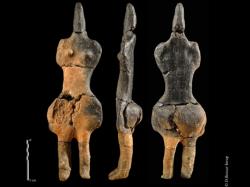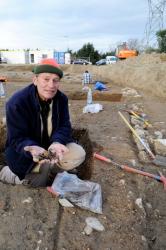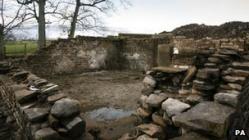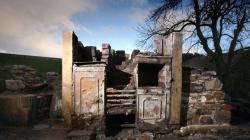08 DECEMBRE
INDI-UNI : ANTHROPOLOGY - ARCHAEOLOGY
INSCRIPTION 2012 COURS A DISTANCE
REGISTRATION 2012 ONLINE COURSES
ALLEMAGNE – Rugen - The piece of porcelain history was discovered in the wreck of the Udine, a light-cruiser which was sunk in the First World War by the Royal Navy, that now lies 28 nautical miles off the German island of Rugen. "It was sunk by the British in 1915," said Reinhard Oser, the archaeologist leading the expedition. "We managed to take some great photographs, and made this unusual discovery." At the time the significance of the urinal went unnoticed until later research revealed that the urinal was part of a special bathroom laid on for the emperor's convenience. "Kaiser Wilhelm was on board the ship when it was launched in Kiel on December 11, 1902, and went on its maiden voyage," explained Mr Oser, who added the team had been surprised by the identity of the urinal's user. The discovery of the regal lavatory has helped focus attention on the vast array of wrecks that litter the seabed of the Baltic. Archaeologists estimate that there as many as 3,000 ships, many of them victims of fighting in either the first or second world war, lie beneath the waves.
http://www.telegraph.co.uk/news/worldnews/europe/germany/8942921/Kaiser-Willhelms-urinal-found-at-bottom-of-Baltic.html
FRANCE –  Villers-Carbonnel - Des archéologues de l’INRAP ont découvert sur le site néolithique de Villers-Carbonnel (Somme) les fragments d’une statuette dans un four dont la voûte de terre s’est effondrée. Ils ont recollé les morceaux et ont eu la surprise de constater qu’elle était entière. D’une taille de 21 cm, cette représentation féminine stylisée frappe par la largeur des hanches, l’absence de bras et la présence d’une tête sans visage, constituée d’un simple cône. Ce type de statue est très rare en France.
Villers-Carbonnel - Des archéologues de l’INRAP ont découvert sur le site néolithique de Villers-Carbonnel (Somme) les fragments d’une statuette dans un four dont la voûte de terre s’est effondrée. Ils ont recollé les morceaux et ont eu la surprise de constater qu’elle était entière. D’une taille de 21 cm, cette représentation féminine stylisée frappe par la largeur des hanches, l’absence de bras et la présence d’une tête sans visage, constituée d’un simple cône. Ce type de statue est très rare en France.
http://www.sciencesetavenir.fr/archeo-paleo/20111208.OBS6285/en-image-la-dame-de-villers-carbonnel.html
FRANCE –  Thouars - Les sondages archéologiques effectués ce jeudi rue Gabriel-de-Bourbon, au pied de l’église Saint-Médard, ont permis de mettre au jour de nouveaux vestiges médiévaux. Outre des ossements de sépultures anciennes, les spécialistes de l’Institut national de recherches archéologiques préventives (Inrap) ont aussi trouvé des sarcophages en pierre.
Thouars - Les sondages archéologiques effectués ce jeudi rue Gabriel-de-Bourbon, au pied de l’église Saint-Médard, ont permis de mettre au jour de nouveaux vestiges médiévaux. Outre des ossements de sépultures anciennes, les spécialistes de l’Institut national de recherches archéologiques préventives (Inrap) ont aussi trouvé des sarcophages en pierre.
http://www.courrierdelouest.fr/actualite/deuxsevres/article_-Thouars.-Des-sarcophages-decouverts-au-pied-de-Saint-Medard_39870-103_actualite.Htm
FRANCE –  Cavaillon - les archéologues de l'Inrap n'ont pas hésité à présenter leur trouvaille comme un "important site gaulois". Situé à environ deux kilomètres à vol d'oiseau de la colline Saint-Jacques, qui surplombe Cavaillon et où se trouvait l'ancien oppidum cavare, ce site aura cependant appris une chose importante pour la connaissance de la ville antique : que l'occupation des lieux allait bien au-delà de la colline et de ses environs immédiats. Voici deux mois, avant que ne soit lancé un vaste chantier de logements sociaux, l'Inrap effectuait plusieurs sondages. Et là , bingo ! Des signes évidents, et en nombre, d'occupation ancienne étaient mis au jour. Dans la foulée, une campagne de fouilles préventives était décidée. En huit semaines, elle aura permis d'exhumer les fondations de maisons ainsi que des fosses qui ont tout l'air d'être des silos ou des puits. Pour les chercheurs, cela ne fait donc pas de doute. Nous sommes ici en présence d'une occupation agricole dont le mobilier découvert sur place (notamment des tessons de vaisselle attique grecque ou des fragments de céramique de même origine) permet de penser sans risque d'erreur qu'il date du IIe siècle avant Jésus-Christ (second âge du fer, pour les spécialistes). "Les Cavares entretenaient des relations commerciales denses avec les populations phocéennes", explique, preuves à l'appui, Robert Gadey, le responsable scientifique du chantier. Les archéologues sont également persuadés que le site a été abandonné par ses habitants au cours du IIe siècle avant J.-C.
Cavaillon - les archéologues de l'Inrap n'ont pas hésité à présenter leur trouvaille comme un "important site gaulois". Situé à environ deux kilomètres à vol d'oiseau de la colline Saint-Jacques, qui surplombe Cavaillon et où se trouvait l'ancien oppidum cavare, ce site aura cependant appris une chose importante pour la connaissance de la ville antique : que l'occupation des lieux allait bien au-delà de la colline et de ses environs immédiats. Voici deux mois, avant que ne soit lancé un vaste chantier de logements sociaux, l'Inrap effectuait plusieurs sondages. Et là , bingo ! Des signes évidents, et en nombre, d'occupation ancienne étaient mis au jour. Dans la foulée, une campagne de fouilles préventives était décidée. En huit semaines, elle aura permis d'exhumer les fondations de maisons ainsi que des fosses qui ont tout l'air d'être des silos ou des puits. Pour les chercheurs, cela ne fait donc pas de doute. Nous sommes ici en présence d'une occupation agricole dont le mobilier découvert sur place (notamment des tessons de vaisselle attique grecque ou des fragments de céramique de même origine) permet de penser sans risque d'erreur qu'il date du IIe siècle avant Jésus-Christ (second âge du fer, pour les spécialistes). "Les Cavares entretenaient des relations commerciales denses avec les populations phocéennes", explique, preuves à l'appui, Robert Gadey, le responsable scientifique du chantier. Les archéologues sont également persuadés que le site a été abandonné par ses habitants au cours du IIe siècle avant J.-C.
http://www.laprovence.com/article/a-la-une/le-site-gaulois-qui-en-dit-long-sur-les-anciens-habitants-de-cavaillon
ROYAUME UNI –
 Barley - Engineers have said they were "stunned" to unearth a 17th Century cottage, complete with a mummified cat, during a construction project in Lancashire. The cottage was discovered near Lower Black Moss reservoir in the village of Barley, in the shadow of Pendle Hill. Archaeologists brought in by United Utilities to survey the area found the building under a grass mound. Historians are now speculating that the well-preserved cottage could have belonged to one of the Pendle witches. The building contained a sealed room, with a mummified cat bricked into the wall. It is believed the cat was buried alive to protect the cottage's inhabitants from evil spirits. Carl Sanders, United Utilities' project manager, said: "It's not often you come across a fairytale cottage complete with witch's cat."The building is in remarkable condition. You can walk through it and get a real sense that you're peering into the past. "Pendle Hill has a real aura about it, and it's hard not to be affected by the place. "Even before we discovered the building, there were lots of jokes from the lads about broomsticks and black cats. The find has really stunned us all." Simon Entwistle, an expert on the Pendle witches, said: We are just a few months away from the 400th anniversary of the Pendle witch trials, and here we have an incredibly rare find, right in the heart of witching country. This could well be the famous Malkin Tower - which has been a source of speculation and rumour for centuries. "Cats feature prominently in folklore about witches. Whoever consigned this cat to such a horrible fate was clearly seeking protection from evil spirits." The building also contains a 19th Century kitchen range, still in its original position. Many artefacts from the building's latter years, such as Victorian crockery, a tin bath and a bedstead, were discovered around the site.
Barley - Engineers have said they were "stunned" to unearth a 17th Century cottage, complete with a mummified cat, during a construction project in Lancashire. The cottage was discovered near Lower Black Moss reservoir in the village of Barley, in the shadow of Pendle Hill. Archaeologists brought in by United Utilities to survey the area found the building under a grass mound. Historians are now speculating that the well-preserved cottage could have belonged to one of the Pendle witches. The building contained a sealed room, with a mummified cat bricked into the wall. It is believed the cat was buried alive to protect the cottage's inhabitants from evil spirits. Carl Sanders, United Utilities' project manager, said: "It's not often you come across a fairytale cottage complete with witch's cat."The building is in remarkable condition. You can walk through it and get a real sense that you're peering into the past. "Pendle Hill has a real aura about it, and it's hard not to be affected by the place. "Even before we discovered the building, there were lots of jokes from the lads about broomsticks and black cats. The find has really stunned us all." Simon Entwistle, an expert on the Pendle witches, said: We are just a few months away from the 400th anniversary of the Pendle witch trials, and here we have an incredibly rare find, right in the heart of witching country. This could well be the famous Malkin Tower - which has been a source of speculation and rumour for centuries. "Cats feature prominently in folklore about witches. Whoever consigned this cat to such a horrible fate was clearly seeking protection from evil spirits." The building also contains a 19th Century kitchen range, still in its original position. Many artefacts from the building's latter years, such as Victorian crockery, a tin bath and a bedstead, were discovered around the site.
http://www.bbc.co.uk/news/uk-england-lancashire-16066680
USA - Jeffersonville - Archaeological workers are expected to resume digging at Colston Park today, where the remains of an abandoned cemetery were discovered last week. Corn Island Owner Anne Bader said since graves have been found, the city would have to move the remains before it could legally build there. “There are burials. We can’t say if some of the burials have been moved or not,” Bader said. She confirmed they’ve found more than 20 burial shafts, as well as pieces of tombstones. The company is tasked with mapping out the boundaries of the cemetery, not moving the graves. Clark County historian Jeanne Burke said most of the graves date back to the early 1800s. Burke believes there may have been about 300 burials. “Most were just townspeople,” she said. It was known as the Old City Cemetery and was actually shown on a lot of early maps.
http://newsandtribune.com/clarkcounty/x1033439772/Dig-to-resume-where-graves-were-found-in-Jeffersonville